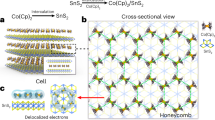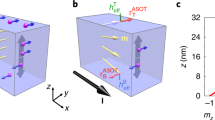Abstract
Molecular semiconductors may exhibit antiferromagnetic correlations well below room temperature1,2,3. Although inorganic antiferromagnetic layers may exchange bias4 single-molecule magnets5, the reciprocal effect of an antiferromagnetic molecular layer magnetically pinning an inorganic ferromagnetic layer through exchange bias has so far not been observed. We report on the magnetic interplay, extending beyond the interface, between a cobalt ferromagnetic layer and a paramagnetic organic manganese phthalocyanine (MnPc) layer. These ferromagnetic/organic interfaces are called spinterfaces because spin polarization arises on them6,7,8. The robust magnetism of the Co/MnPc spinterface6,9 stabilizes antiferromagnetic ordering at room temperature within subsequent MnPc monolayers away from the interface. The inferred magnetic coupling strength is much larger than that found in similar bulk10,11, thin1 or ultrathin2 systems. In addition, at lower temperature, the antiferromagnetic MnPc layer induces an exchange bias on the Co film, which is magnetically pinned. These findings create new routes towards designing organic spintronic devices.
This is a preview of subscription content, access via your institution
Access options
Subscribe to this journal
Receive 12 print issues and online access
$259.00 per year
only $21.58 per issue
Buy this article
- Purchase on Springer Link
- Instant access to full article PDF
Prices may be subject to local taxes which are calculated during checkout




Similar content being viewed by others
References
Serri, M. et al. High-temperature antiferromagnetism in molecular semiconductor thin films and nanostructures. Nature Commun. 5, 3079 (2014).
Chen, X. et al. Probing superexchange interaction in molecular magnets by spin-flip spectroscopy and microscopy. Phys. Rev. Lett. 101, 197208 (2008).
Heutz, S. et al. Molecular thin films: A new type of magnetic switch. Adv. Mater. 19, 3618–3622 (2007).
Stamps, R. L. Mechanisms for exchange bias. J. Phys. D 33, R247–R268 (2000).
Lodi Rizzini, A. et al. Exchange biasing single molecule magnets: Coupling of TbPc2 to antiferromagnetic layers. Nano Lett. 12, 5703–5707 (2012).
Djeghloul, F. et al. Direct observation of a highly spin-polarized organic spinterface at room temperature. Sci. Rep. 3, 1272 (2013).
Raman, K. V. et al. Interface-engineered templates for molecular spin memory devices. Nature 493, 509–513 (2013).
Barraud, C. et al. Unravelling the role of the interface for spin injection into organic semiconductors. Nature Phys. 6, 615–620 (2010).
Javaid, S. et al. Impact on interface spin polarization of molecular bonding to metallic surfaces. Phys. Rev. Lett. 105, 077201 (2010).
Barraclough, C. G., Martin, R. L., Mitra, S. & Sherwood, R. C. Paramagnetic anisotropy, electronic structure, and ferromagnetism in spin S = 3/2 manganese(II) phthalocyanine. J. Chem. Phys. 53, 1638–1642 (2003).
Yamada, H., Shimada, T. & Koma, A. Preparation and magnetic properties of manganese(II) phthalocyanine thin films. J. Chem. Phys. 108, 10256–10261 (1998).
Jiang, J. Functional Phtalocyanine Molecular Materials (Springer, 2010).
Wu, W., Harrison, N. M. & Fisher, A. J. Electronic structure and exchange interactions in cobalt-phthalocyanine chains. Phys. Rev. B 88, 024426 (2013).
Scheybal, A. et al. Induced magnetic ordering in a molecular monolayer. Chem. Phys. Lett. 411, 214–220 (2005).
Wende, H. et al. Substrate-induced magnetic ordering and switching of iron porphyrin molecules. Nature Mater. 6, 516–520 (2007).
Javaid, S. et al. Chemisorption of manganese phthalocyanine on Cu(001) surface promoted by van der Waals interactions. Phys. Rev. B 87, 155418 (2013).
Annese, E., Casolari, F., Fujii, J. & Rossi, G. Interface magnetic coupling of Fe-phthalocyanine layers on a ferromagnetic surface. Phys. Rev. B 87, 054420 (2013).
Annese, E., Fujii, J., Vobornik, I., Panaccione, G. & Rossi, G. Control of the magnetism of cobalt phthalocyanine by a ferromagnetic substrate. Phys. Rev. B 84, 174443 (2011).
Sanvito, S. Molecular spintronics. Chem. Soc. Rev. 40, 3336–3355 (2011).
Stöhr, J. & Siegmann, H. C. Magnetism From Fundamentals to Nanoscale Dynamics (Springer, 2006).
Kataoka, T. et al. Electronic configuration of Mn ions in the π-d molecular ferromagnet β-Mn phthalocyanine studied by soft X-ray magnetic circular dichroism. Solid State Commun. 152, 806–809 (2012).
Teramura, Y., Tanaka, A. & Jo, T. Effect of Coulomb interaction on the X-Ray magnetic circular dichroism spin sum rule in 3d transition elements. J. Phys. Soc. Jpn 65, 1053–1055 (1996).
Fitzsimmons, M. R. et al. Asymmetric magnetization reversal in exchange-biased hysteresis loops. Phys. Rev. Lett. 84, 3986–3989 (2000).
O’Grady, K., Fernandez-Outon, L. E. & Vallejo-Fernandez, G. A new paradigm for exchange bias in polycrystalline thin films. J. Magn. Magn. Mater. 322, 883–899 (2010).
Stamps, R. L. et al. The 2014 Magnetism Roadmap. J. Phys. D 47, 333001 (2014).
Ohresser, P. et al. DEIMOS: A beamline dedicated to dichroism measurements in the 350–2500 eV energy range. Rev. Sci. Instrum. 85, 013106 (2014).
Joly, L. et al. Fast continuous energy scan with dynamic coupling of the monochromator and undulator at the DEIMOS beamline. J. Synchrotron Radiat. 21, 502–506 (2014).
Acknowledgements
We thank B. Muller, A. Boulard, B. Leconte and C. Kieber for technical assistance. We thank D. Lacour and Y. Henry for scientific insight. We thank P. Rengasamy, G. Schmerber and C. Ulhaq for auxiliary measurements. We acknowledge funding from the Franco-German University and the Baden-Württemberg Stiftung in the framework of the Kompetenznetz für Funktionale Nanostrukturen (KFN), from the Alexander von Humboldt foundation, from the Institut Carnot MICA’s ‘Spinterface’ grant, from the Agence Nationale de la Recherche ANR-09-JCJC-0137 and ANR-11-LABX-0058 NIE and from the International Center for Frontier Research in Chemistry. The MBE chamber used during our beamtime on DEIMOS was funded by the Agence National de la Recherche; grant ANR-05-NANO-073. This work was performed using HPC resources from the Strasbourg Mesocenter and from GENCI-CINES Grant 2014-gem1100.
Author information
Authors and Affiliations
Contributions
M.G., S.B., E.B. and M.B. conceived and designed the experiments. J.A. purified the molecules. M.G., L.J., V.D.C., S.B., M.S., H.I., M.P., H.J., V.D.C., F.S., W.Weber, E.B. and M.B. carried out XAS measurements. M.G., S.B., M.B., V.D.C., U.H., W.Weber and E.B. carried out MOKE experiments. H.I., J.C. and W.Wulfhekel performed STM experiments. M.G. analysed the data. F.I. and M.A. performed the ab initio study. F.C., E.O., K.C. and P.O. performed control experiments. M.G., M.B. and E.B. co-wrote the paper. All the authors discussed the results and commented on the manuscript.
Corresponding authors
Ethics declarations
Competing interests
The authors declare no competing financial interests.
Supplementary information
Supplementary Information
Supplementary Information (PDF 4686 kb)
Rights and permissions
About this article
Cite this article
Gruber, M., Ibrahim, F., Boukari, S. et al. Exchange bias and room-temperature magnetic order in molecular layers. Nature Mater 14, 981–984 (2015). https://doi.org/10.1038/nmat4361
Received:
Accepted:
Published:
Issue Date:
DOI: https://doi.org/10.1038/nmat4361
This article is cited by
-
Exchange-induced spin polarization in a single magnetic molecule junction
Nature Communications (2022)
-
Measuring molecular magnets for quantum technologies
Nature Reviews Physics (2021)
-
Activating the molecular spinterface
Nature Materials (2017)
-
A molecular jigsaw puzzle
Nature Materials (2017)
-
Dynamic spin filtering at the Co/Alq3 interface mediated by weakly coupled second layer molecules
Nature Communications (2016)



